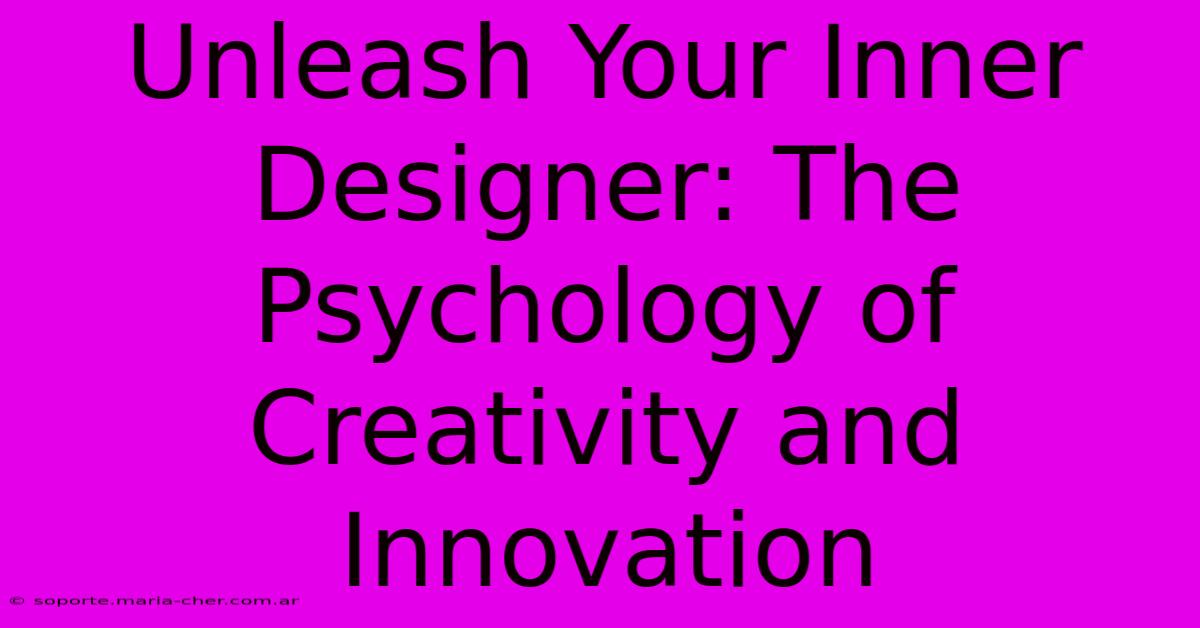Unleash Your Inner Designer: The Psychology Of Creativity And Innovation

Table of Contents
Unleash Your Inner Designer: The Psychology of Creativity and Innovation
Want to unlock your creative potential and become a more innovative thinker? It's not just about talent; it's about understanding the psychology behind creativity. This article delves into the fascinating world of creative thinking, exploring the mental processes and techniques that can help you unleash your inner designer and generate groundbreaking ideas.
Understanding the Creative Process: More Than Just Inspiration
Creativity isn't a mystical gift bestowed upon a select few. It's a process, a series of cognitive steps anyone can learn to master. Think of it like learning a new language – it takes time, practice, and a willingness to experiment. The creative process often involves these key stages:
1. Preparation: Laying the Groundwork
This initial phase involves gathering information, researching, and immersing yourself in the problem or challenge at hand. Active learning is crucial here. Don't just passively consume information; actively engage with it, ask questions, and challenge assumptions. The more you know, the more connections your brain can make.
2. Incubation: Letting Your Subconscious Work its Magic
This is where the magic happens. After actively engaging with the problem, step away. Let your subconscious mind work on the information you've gathered. This often involves engaging in activities unrelated to the problem – a walk in nature, listening to music, or even a good night's sleep. This period of cognitive rest allows for new connections and insights to emerge.
3. Illumination: The "Aha!" Moment
This is the exciting stage where a breakthrough occurs – the "aha!" moment. A solution, a new perspective, or a creative idea suddenly appears, often unexpectedly. This is the result of your subconscious processing the information during the incubation phase.
4. Verification: Refining and Implementing Your Idea
This final stage involves testing, refining, and implementing your idea. This is where critical thinking comes in. You evaluate your solution, identify potential flaws, and make improvements. This iterative process ensures your creative output is not only innovative but also effective.
Psychological Factors Influencing Creativity
Several psychological factors significantly impact our creative capacity:
1. Mindset: Embrace a Growth Mindset
Believe in your ability to learn and grow. A growth mindset fosters resilience and a willingness to experiment, even if it means making mistakes. This is crucial for creativity because innovative solutions often require trying different approaches until one works.
2. Intrinsic Motivation: The Drive Within
Creativity flourishes when driven by internal motivation rather than external pressure. When you're genuinely passionate about a project, you're more likely to persevere through challenges and generate innovative solutions.
3. Openness to Experience: Exploring New Perspectives
Individuals high in openness to experience are curious, imaginative, and receptive to new ideas. They actively seek out diverse perspectives and embrace ambiguity, which are crucial for creative thinking.
4. Cognitive Flexibility: Thinking Outside the Box
Cognitive flexibility refers to the ability to switch between different tasks, ideas, and perspectives. It's essential for overcoming mental blocks and generating diverse solutions.
Techniques to Boost Your Creativity
Several techniques can help you enhance your creative thinking:
- Brainstorming: Generating a large number of ideas without judgment.
- Mind mapping: Visually organizing ideas and their relationships.
- SCAMPER: A checklist of creative prompts to stimulate new ideas (Substitute, Combine, Adapt, Modify, Put to other uses, Eliminate, Reverse).
- Lateral thinking: Approaching problems from unconventional angles.
- Design thinking: A human-centered approach to problem-solving.
Conclusion: Nurturing Your Creative Spirit
Unleashing your inner designer requires cultivating a supportive environment, fostering a growth mindset, and actively practicing creative techniques. By understanding the psychology behind creativity and innovation, you can empower yourself to generate groundbreaking ideas and achieve your creative goals. Remember, creativity is a skill that can be developed and honed over time – so start exploring your potential today!

Thank you for visiting our website wich cover about Unleash Your Inner Designer: The Psychology Of Creativity And Innovation. We hope the information provided has been useful to you. Feel free to contact us if you have any questions or need further assistance. See you next time and dont miss to bookmark.
Featured Posts
-
Create Floral Masterpieces Without Breaking The Bank Unmissable Discounts On Dried Flowers
Feb 08, 2025
-
Dimension Dilemma Cracking The Code Of W X H And H X W
Feb 08, 2025
-
Unveiling The Wholesale Babys Breath Masterpiece You Ve Been Dreaming Of
Feb 08, 2025
-
Size Matters Whats The Optimal Polaroid Dimension For Every Occasion
Feb 08, 2025
-
Roses Roses Everywhere Your One Stop Shop For Wholesale Beauty
Feb 08, 2025
